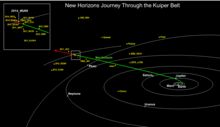2011 KW48
| Discovery[1] | |
|---|---|
| Discovered by | New Horizons KBO Search(266) |
| Discovery site | Subaru Telescope |
| Discovery date | 29 May 2011 (discovery: first observed only) |
| Designations | |
| 2011 KW48 | |
| VNH0004 | |
| TNO[1]·inner classic[2] distant[3] | |
| Orbital characteristics[1] | |
| Epoch8 June 2011 (JD2455720.5) | |
| Uncertainty parametern.a.[1][3] | |
| Observation arc | 34 days |
| Aphelion | 42.676AU |
| Perihelion | 32.368 AU |
| 37.522 AU | |
| Eccentricity | 0.1374 |
| 229.84yr(83,950 days) | |
| 347.91° | |
| 0° 0m15.48s/ day | |
| Inclination | 3.6328° |
| 246.15° | |
| 46.931° | |
| Physical characteristics | |
| 77 km[2] | |
| 0.09(estimate)[2] | |
| 8.8[1] | |
2011 KW48,temporarily designatedVNH0004,is atrans-Neptunian objectfrom theinner classicalpart of theKuiper belt,located in the outermost region of theSolar System.It measures approximately 77 kilometers (48 mi) in diameter.
The object was first observed on 29 May 2011, during theNew Horizons KBO Search(266) conducted by astronomers using theSubaru Telescopeat theMauna Kea Observatoryon Hawaii, United States.[3]It was later observed by theNew Horizonsspace probe from afar in January 2015.[4][5]
Orbit and classification[edit]
2011 KW48orbits the Sun at a distance of 32.4–42.7AUonce every 229 years and 10 months (83,950 days;semi-major axisof 37.5 AU). Its orbit has aneccentricityof 0.14 and aninclinationof 3.6°with respect to theecliptic.[1]
This object was observed 12 times by theMauna Kea(8) andLas Campanas(4) observatories over a period of about 33.8 days between 29 May and 2 July 2011. Because of this short period of observation, its current orbit is extremely uncertain.[1][3]
New Horizons[edit]

Between 4–15 January 2015,[4]theNew Horizonsspacecraft actively observed this object – then temporarily designatedVNH0004– at a distance of about 0.5 AU (75 million km; 46 million mi).[5]While this was too far to resolve surface features or perform spectroscopic analyses of its composition, the spacecraft was able to search for possible satellites and observe itsphase curve.[5]
Physical characteristics[edit]
Based on anabsolute magnitudeof 8.8,[1]and an assumedalbedoof 0.09, theJohnston'sarchiveestimates amean diameterof approximately 77 kilometers (48 mi).[2]As of 2018, no rotationallightcurveof2011 KW48has been obtained from photometric observations. The object'srotation period,poleand shape remain unknown.[1][6]
Numbering and naming[edit]
As of 2018, thisminor planethas not beennumberedornamed.[3]
See also[edit]
References[edit]
- ^abcdefghi"JPL Small-Body Database Browser: (2011 KW48)"(2011-07-02 last obs.).Jet Propulsion Laboratory.Retrieved7 February2018.
- ^abcdJohnston, Wm. Robert (30 December 2017)."List of Known Trans-Neptunian Objects".Johnston's Archive.Retrieved7 February2018.
- ^abcde"2011 KW48".Minor Planet Center.Retrieved7 February2018.
- ^abGebhardt, Chris (19 January 2015)."New Horizons begins Pluto observations ahead of July flyby".NASASpaceFlight.com.Retrieved7 February2018.
- ^abcPaul, Christopher (31 August 2012)."New Horizons to Encounter KBO Ahead of Pluto Flyby".AmericaSpace.Retrieved7 February2018.
- ^"LCDB Data for (2011 KW48) – Not yet in Data Base".Asteroid Lightcurve Database (LCDB).Retrieved7 February2018.
External links[edit]
- Orbit Fit and Astrometric record for VNH0004,Southwest Research Institute,25 October 2014
- List of Transneptunian Objects,Minor Planet Center
- Asteroid Lightcurve Database (LCDB),query form (infoArchived16 December 2017 at theWayback Machine)
- 2011 KW48at theJPL Small-Body Database

